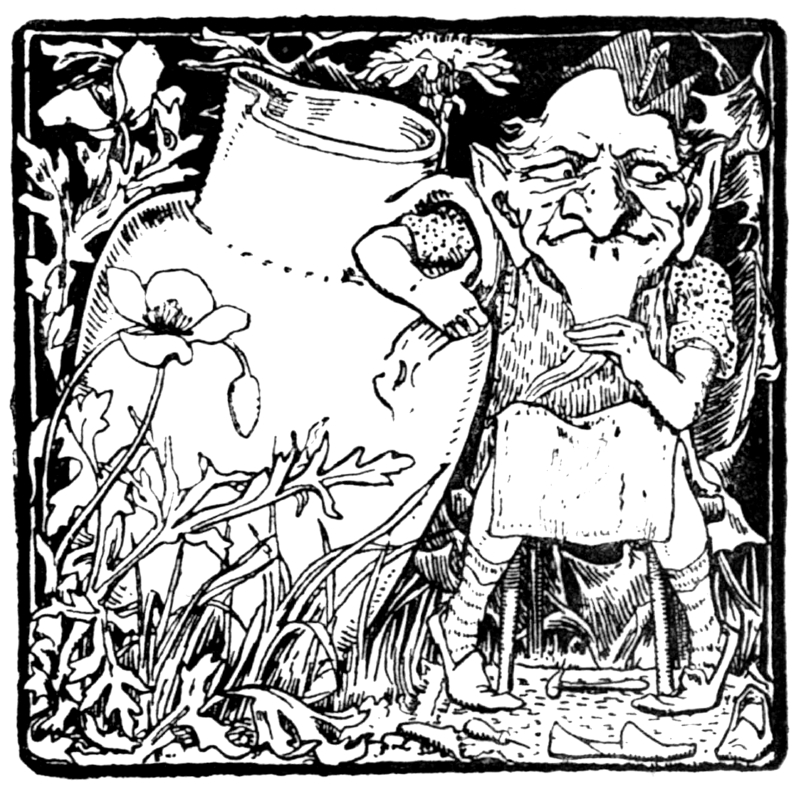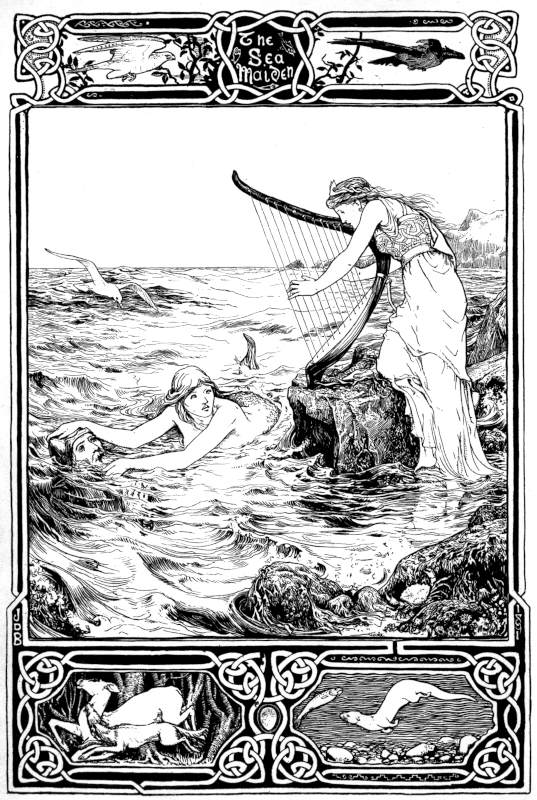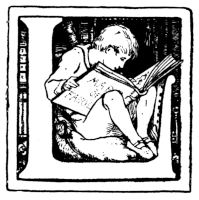 |
|
||
| Kellscraft
Studio Home Page |
Wallpaper
Images for your Computer |
Nekrassoff Informational Pages |
Web
Text-ures© Free Books on-line |
|
Celtic Fairy Tales Selected and
Edited By Joseph Jacobs Editor of
"Folk Lore" Illustrated
by John D.
Batten
London David Nutt.
270 Strand 1892
TO ALFRED
NUTT PREFACE
In making
my selection I have chiefly tried to make the stories characteristic.
It would have
been easy, especially from Kennedy, to have made up a volume entirely
filled with
"Grimm's Goblins" à la Celtique. But one can have too much even
of that very good thing, and I have therefore avoided as far as
possible the more
familiar "formulae" of folk-tale literature. To do this I had to
withdraw
from the English-speaking Pale both in Scotland and Ireland, and I laid
down the
rule to include only tales that have been taken down from Celtic
peasants ignorant
of English. Having
laid down the rule, I immediately proceeded to break it. The success of
a fairy
book, I am convinced, depends on the due admixture of the comic and the
romantic:
Grimm and Asbjörnsen knew this secret, and they alone. But the Celtic
peasant who
speaks Gaelic takes the pleasure of telling tales somewhat sadly: so
far as he has
been printed and translated, I found him, to my surprise, conspicuously
lacking
in humour. For the comic relief of this volume I have therefore had to
turn mainly
to the Irish peasant of the Pale; and what richer source could I draw
from? For the
more romantic tales I have depended on the Gaelic, and, as I know about
as much
of Gaelic as an Irish Nationalist M. P., I have had to depend on
translators. But
I have felt myself more at liberty than the translators themselves, who
have generally
been over-literal, in changing, excising, or modifying the original. I
have even
gone further. In order that the tales should be characteristically
Celtic, I have
paid more particular attention to tales that are to be found on both
sides of the
North Channel. In
re-telling
them I have had no scruple in interpolating now and then a Scotch
incident into
an Irish variant of the same story, or vice versa. Where the
translators
appealed to English folklorists and scholars, I am trying to attract
English children.
They translated; I endeavoured to transfer. In short, I have tried to
put myself
into the position of an ollamh or sheenachie familiar
with both forms
of Gaelic, and anxious to put his stories in the best way to attract
English children.
I trust I shall be forgiven by Celtic scholars for the changes I have
had to make
to effect this end. The stories
collected in this volume are longer and more detailed than the English
ones I brought
together last Christmas. The romantic ones are certainly more romantic,
and the
comic ones perhaps more comic, though there may be room for a
difference of opinion
on this latter point. This superiority of the Celtic folk-tales is due
as much to
the conditions under which they have been collected, as to any innate
superiority
of the folk-imagination. The folk-tale in England is in the last stages
of exhaustion.
The Celtic folk-tales have been collected while the practice of
story-telling is
still in full vigour, though there are every signs that its term of
life is already
numbered. The more the reason why they should be collected and put on
record while
there is yet time. On the whole, the industry of the collectors of
Celtic folk-lore
is to be commended, as may be seen from the survey of it I have
prefixed to the
Notes and References at the end of the volume. Among these, I would
call attention
to the study of the legend of Beth Gellert, the origin of which, I
believe, I have
settled. While
I have endeavoured to render the language of the tales simple and free
from bookish
artifice, I have not felt at liberty to retell the tales in the English
way. I have
not scrupled to retain a Celtic turn of speech, and here and there a
Celtic word,
which I have not explained within brackets — a practice to be
abhorred of
all good men. A few words unknown to the reader only add effectiveness
and local
colour to a narrative, as Mr. Kipling well knows. One
characteristic
of the Celtic folk-lore I have endeavoured to represent in my
selection, because
it is nearly unique at the present day in Europe. Nowhere else is there
so large
and consistent a body of oral tradition about the national and mythical
heroes as
amongst the Gaels. Only the byline, or hero-songs of Russia,
equal in extent
the amount of knowledge about the heroes of the past that still exists
among the
Gaelic-speaking peasantry of Scotland and Ireland. And the Irish tales
and ballads
have this peculiarity, that some of them have been extant, and can be
traced, for
well nigh a thousand years. I have selected as a specimen of this class
the Story
of Deirdre, collected among the Scotch peasantry a few years ago, into
which I have
been able to insert a passage taken from an Irish vellum of the twelfth
century.
I could have more than filled this volume with similar oral traditions
about Finn
(the Fingal of Macpherson's "Ossian"). But the story of Finn, as told
by the Gaelic peasantry of to-day, deserves a volume by itself, while
the adventures
of the Ultonian hero, Cuchulain, could easily fill another. I have
endeavoured to include in this volume the best and most typical stories
told by
the chief masters of the Celtic folk-tale, Campbell, Kennedy, Hyde, and
Curtin,
and to these I have added the best tales scattered elsewhere. By this
means I hope
I have put together a volume, containing both the best, and the best
known folk-tales
of the Celts. I have only been enabled to do this by the courtesy of
those who owned
the copyright of these stories. Lady Wilde has kindly granted me the
use of her
effective version of "The Horned Women;" and I have specially to thank
Messrs. Macmillan for right to use Kennedy's "Legendary Fictions," and
Messrs. Sampson Low & Co., for the use of Mr. Curtin's Tales. In making
my selection, and in all doubtful points of treatment, I have had
resource to the
wide knowledge of my friend Mr. Alfred Nutt in all branches of Celtic
folk-lore.
If this volume does anything to represent to English children the
vision and colour,
the magic and charm, of the Celtic folk-imagination, this is due in
large measure
to the care with which Mr. Nutt has watched its inception and progress.
With him
by my side I could venture into regions where the non-Celt wanders at
his own risk. Lastly,
I have again to rejoice in the co-operation of my friend, Mr. J. D.
Batten, in giving
form to the creations of the folk-fancy. He has endeavoured in his
illustrations
to retain as much as possible of Celtic ornamentation; for all details
of Celtic
archaeology he has authority. Yet both he and I have striven to give
Celtic things
as they appear to, and attract, the English mind, rather than attempt
the hopeless
task of representing them as they are to Celts. The fate of the Celt in
the British
Empire bids fair to resemble that of the Greeks among the Romans. "They
went
forth to battle, but they always fell," yet the captive Celt has
enslaved his
captor in the realm of imagination. The present volume attempts to
begin the pleasant
captivity from the earliest years. If it could succeed in giving a
common fund of
imaginative wealth to the Celtic and the Saxon children of these isles,
it might
do more for a true union of hearts than all your politics. JOSEPH
JACOBS. Contents Connla and the Fairy Maiden Guleesh The Field of Boliauns The Horned Women Conall Yellowclaw Hudden and Dudden and Donald O'Neary The Shepherd of Myddvai The Sprightly Tailor The Story of Deirdre Munachar and Manachar Gold-Tree and Silver-Tree King O'Toole and his Goose The Wooing of Olwen Jack and his Comrades The Shee an Gannon and the Gruagach Gaire The Story-Teller at Fault The Sea-Maiden A Legend of Knockmany Fair, Brown, and Trembling Jack and His Master Beth Gellert The Tale of Ivan Andrew Coffey The Battle of the Birds Brewery of Eggshells The Lad with the Goat-Skin Notes and References |


 ast year, in giving the
young ones a
volume of English Fairy Tales, my difficulty was one of collection.
This time, in
offering them specimens of the rich folk-fancy of the Celts of these
islands, my
trouble has rather been one of selection. Ireland began to collect her
folk-tales
almost as early as any country in Europe, and Croker has found a whole
school of
successors in Carleton, Griffin, Kennedy, Curtin, and Douglas Hyde.
Scotland had
the great name of Campbell, and has still efficient followers in
MacDougall, MacInnes,
Carmichael, Macleod, and Campbell of Tiree. Gallant little Wales has no
name to
rank alongside these; in this department the Cymru have shown less
vigour than the
Gaedhel. Perhaps the Eisteddfod, by offering prizes for the collection
of Welsh
folk-tales, may remove this inferiority. Meanwhile Wales must be
content to be somewhat
scantily represented among the Fairy Tales of the Celts, while the
extinct Cornish
tongue has only contributed one tale.
ast year, in giving the
young ones a
volume of English Fairy Tales, my difficulty was one of collection.
This time, in
offering them specimens of the rich folk-fancy of the Celts of these
islands, my
trouble has rather been one of selection. Ireland began to collect her
folk-tales
almost as early as any country in Europe, and Croker has found a whole
school of
successors in Carleton, Griffin, Kennedy, Curtin, and Douglas Hyde.
Scotland had
the great name of Campbell, and has still efficient followers in
MacDougall, MacInnes,
Carmichael, Macleod, and Campbell of Tiree. Gallant little Wales has no
name to
rank alongside these; in this department the Cymru have shown less
vigour than the
Gaedhel. Perhaps the Eisteddfod, by offering prizes for the collection
of Welsh
folk-tales, may remove this inferiority. Meanwhile Wales must be
content to be somewhat
scantily represented among the Fairy Tales of the Celts, while the
extinct Cornish
tongue has only contributed one tale.